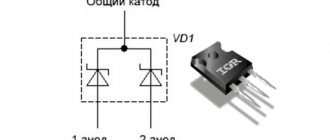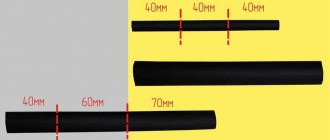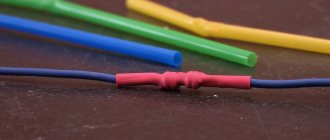Heat shrink is heat-shrinkable tubing made from thermopolymers. The product changes its size under the influence of hot water, air or open flame. The main feature is a high transverse compression ratio relative to the longitudinal one. The tube can reduce its diameter by 2-6 times, and at the same time, its length will decrease by no more than 20% or even less. Designed for electrical insulation and mechanical protection of all kinds of connections.
Heat shrink tubing is an innovative insulation method that is used when working with electricity. This material is much preferable to traditional insulating tape, as it creates a uniform, completely sealed electrical insulating layer.
In the article we will answer the questions - how to heat a heat-shrinkable tube, what technical characteristics the product has, and the tools with which you can heat it.
Main characteristics
Heat-shrinkable tubing is a special insulating element that, when heated, changes its diameter, indicated in millimeters (mm), reliably protects and insulates the base placed inside from damage.
Heat-shrinkable tubes are made from heat-polymer materials with high heat-resistant properties.
There are certain requirements that apply to heat shrink elements:
- elasticity;
- resistance to high temperatures;
- lack of flammability;
- resistance to aggressive environments;
- rapid deformation;
- tensile strength – 15 MPa and above;
- elasticity - the ability to increase by 300% of the original size.
The most popular insulator are tubes that can deform at temperatures from 55 to 120 degrees Celsius, but there are products that can withstand heating up to +300 C.
The properties of this thermal insulation allow, when heated, to completely follow the contours of the object that should be insulated.
Basically, thermal insulating elements are used for electrical insulation of contacts, wires, terminals, but in some cases this material is used to protect metal products from corrosion.
Application area:
- electricity;
- cable production;
- protection of equipment used in electrical installation work;
- installation, repair of couplings;
- marking of wiring during insulation through the use of elements of different colors;
- in nuclear energy as a supplement during installation work.
In addition, it is used to protect wires from destruction and insulate objects in all areas of production.
Buying heat shrink tube: product prices
Heat-shrinkable tubing is available in any hardware store. They can be ordered on the Internet, purchased from specialized organizations that deal with low-current communications and solve power supply issues, in electrical and lighting stores.
Products are delivered to stores in slices or in coils of 10-100 m
The most popular manufacturers include the following companies:
- LG;
- Zeux;
- DAG-Canusa;
- Sumitomo;
- 3M;
- Raychem.
However, the cost of branded products is quite high, so not all buyers can afford them. Among Russian brands, Thermoform, Metatron and TMARK are popular.
Prices for different types of heat shrinks:
| product name | Marking | Number of products per package, pcs. | Price, rub./piece |
| End tip (fork) | F06R5 | 100 | 3,9 |
| F06B4 | 4,05 | ||
| F06B5 | 4,36 | ||
| F06Y4 | 6,22 | ||
| F06Y5 | 6,66 | ||
| F06Y6 | 7,13 | ||
| End tip (ring) | R06B4 | 100 | 4,05 |
| R06B6 | 4,79 | ||
| R06B10 | 5,56 | ||
| R06B12 | 5,99 | ||
| NR06Y4 | 7,05 | ||
| NR06Y5 | 7,28 | ||
| End connector | ENDCAP-2216 | 50 | 9 |
| ENDCAP-2214 | 10,5 | ||
| ENDCAP-1810 | 13,5 | ||
| Flat connector with female connector | P06R63E | 100 | 5,4 |
| P06B63E | 5,86 | ||
| NP06R63E | 5,99 | ||
| NP06B63E | 6,47 | ||
| P06Y63 | 7,91 | ||
| NP06Y63E | 8,66 | ||
| Flat connector with male connector | T06R63E | 100 | 4,66 |
| T06B63E | 5,1 | ||
| NT06R63E | 5,18 | ||
| NT06B63E | 5,63 | ||
| T06Y63E | 7,13 | ||
| NT06Y63 | 7,86 | ||
| A tube | 06-1,25 | 100 | 3,06 |
| N06-0.5 | 3,38 | ||
| N06-1.26 | 3,38 | ||
| N06-2 | 4,27 | ||
| 06-5,5 | 6,66 | ||
| Solder tube | SST-100-01 | 100 | 7,06 |
| SST-100-02 | 8,86 | ||
| SST-100-03 | 9,46 | ||
| SST-100-04 | 11,25 | ||
| SST-205-04 | 12,24 |
Helpful advice! To insulate connections on harnesses, power cables and pipes, it is better to use heat shrink with a compression ratio of 6:1.
Open flame shrinkage - pros and cons
An open flame is a lighter, candle, match or other source of fire. If we consider an open flame for heating, then it is worth knowing some nuances:
- Thermal insulation may undergo severe deformation when exposed to strong heating;
- If the flame is not removed in time, the heat shrink may simply burn out;
- White, colored heat-shrinkable element may smoke when heated.
The main problem with open fire shrinkage is that the source of heat is always at the bottom, and in order to heat the insulator evenly, the connection must be constantly rotated. This is the only way it will heat up evenly.
In addition, you must strictly maintain the distance from the structure to the open fire. It should not be less than 3-4 cm; it is at this distance from the flame that the temperature is highest. Do not use gas burners or turbo lighters for heat shrink tube for heating - it will immediately become unusable.
Description
Until the 50s of the twentieth century, PVC tape was used to insulate bare conductors of electrical wires. A more convenient means of achieving the same goal was the invention of cambric. These are relatively rigid hollow tubes made of a material similar to electrical tape. Inscriptions were applied to them, and to fix them on the cable it was enough to use an open fire and pliers to clamp the melted edges.
Today, multi-colored thermopolymer insulation is more often used as an alternative.
Note! The property of such tubes is shrinkage under the influence of hot water or steam, heated air or open fire.
Temperature effect
In this case, the narrowing occurs in the diametrical (2-6 times) rather than longitudinal direction (from 7 to 20%). And only on the part on which thermal pressure is applied. This creates a thick-walled insulating protection for the exposed node contacts.
Application of various methods for heating
There are several heating methods, each of which can provide high-quality heat treatment. But there are also some that are not recommended.
The most popular, at the same time controversial option is a lighter or matches . This option can be used if there is no other source of high temperature at hand. You can only shrink a small section of wire with a small cross-section using this method. This option is not suitable for large structures.
If we are talking about large products, then heating will take a lot of time, and the connection itself will turn out to be of poor quality. And how many times will this procedure need to be repeated if it is necessary to process several areas with a large cross-section?
The same can be said about the lighter. Some home craftsmen try to use a regular hair dryer for shrinking, which every housewife has. But it is worth remembering that this device cannot provide the required temperature, so high-quality compression of the insulation will not work.
Important! Depending on the brand of material, the heating temperature is 90-150 degrees.
A household hair dryer produces a stream of hot air t 700 C at the outlet of the nozzle. If you use a narrow nozzle, then of course it is possible to heat a small area with a small diameter; as for large sections, the hair dryer will simply fail, and the insulation will turn out to be of poor quality and unreliable. Do not forget that there are some heat shrink models that can be compressed at a heating temperature of 350 degrees.
The result of such work may be a loose fit of the material to the insulation site, into which moisture can easily penetrate, so it is worth using a special tool.
Choice
The choice is based on various parameters. These include tube length (ready cut or per meter from the roll) and thickness. Thin-walled, medium-value and thick-walled thermotubes are available for sale. Regarding the diameter, the difference between the initial state and after temperature exposure is important. That is, the thermal casing should fit freely onto the cable and fit tightly after compression.
For specialized tasks, there are products that have some additions, for example:
- large diameter;
- surface corrugation;
- increased density.
Additions
When choosing products, it is important to understand the labeling in which the manufacturer includes information about the product ready for use. Only the diameters or ratio are always indicated, for example, ø10.0/5.0 (in mm or inches), 20 mm 2:1. The remaining parameters are optional. These include: operating and shrinkage temperatures, elongation limit before breaking, rated voltage, material, brand.
You might be interested in this: How do motion sensors work to turn on lights?
Heat Shrink Tools
In fact, there are only five heating construction tools. Let's look at them:
- construction high-temperature hair dryer for heat-shrinkable tube;
- special butane-based burners;
- gas soldering irons;
- propane burners;
- infrared device.
The best option for heating heat-shrinkable, thin-walled elements is a construction hair dryer . Its temperature conditions can be adjusted; in addition, you can purchase special nozzles for uniform heating.
Its disadvantage is that the heating of thick-walled material will take a long time, and the quality of compression will be unsatisfactory.
Before you start heating with a hairdryer, you need to hold the heating area with your hand so that the strong air flow from the nozzle does not cause the element to move from its place.
A burner with infrared radiation does not have these disadvantages, since heating is carried out in a matter of minutes, without a strong air flow.
Important! When using infrared radiation, you should know that elements of black or dark shades absorb heat faster, so there is a high probability of burning through the thermal insulation when heated.
Gas burners are good to use because the flame has several functions. It is worth understanding that shrinkage should be done on the softest flame. How can you tell if the flame is soft? Adjust the burner so that all flames are yellow; the same indicators should be used when using a gas soldering iron.
Interesting to know! Since this thermal insulation is used everywhere, including in mechanical engineering, the question arises: how to heat the heat-shrinkable tube for a gas pipeline. There is one most important limitation: open fire in any form cannot be used for heating. It is better to use a hair dryer or an infrared emitter to insulate the gas pipeline.
A propane torch is the most suitable tool for compressing thick-walled thermal insulation elements.
The correct choice of devices for heat shrink work depends on the following nuances:
- Thermal insulator size;
- Wall thickness;
- Material of manufacture.
Before choosing one heating method or another, study the characteristics of the material you plan to use.
Watch the video - how to use heat shrink, how to heat it, etc.
HOW TO USE HEAT SHRINK TUBE [Radio AmateurTV 86]
How is heat shrink better than electrical tape?
There are two main indicators for which thermal tubes are preferable to insulating tape:
- When using a thermal insulator, you don’t have to worry that it will lose its desired properties over time;
- the electrical tape sticks to the insulated surface and leaves a dirty mark on it. As for thermal tubes, with the correct selection of shade, you can get an aesthetic appearance of any product. Removing the material is not difficult: you just need to cut the heat-shrinkable tube lengthwise;
- a very convenient material, if the contacts are very close to each other and wrapping with electrical tape is problematic - there is not enough space.
Thanks to their positive qualities, thermal tubes have become so popular and are used in many fields of activity.
Heat shrink tubing or electrical tape
Types of tubes, how to choose according to characteristics
There are several types of heat-shrinkable tubes, differing in design and nature of operation:
- Adhesive heat-shrinkable tube – has an adhesive layer on the inside. This is a very popular material for insulation, since when heated, the joints are completely sealed. Thanks to this, the connection is reliable. The shrinkage coefficient of this tube is 300%, which allows you to isolate objects whose diameter is much smaller than the tube itself. The adhesive heat-shrink tube can be cut, if it is not possible to put it on the element entirely, and then heat it up; thanks to the inner layer, the seam is hermetically sealed.
- Thick-walled thermo-shrinkable tube - made from polyolefin. This is a very affordable insulator, it is easy to use, and such a tube costs much less than an adhesive tube. This thermal insulator has a very wide range of colors and can be divided into:
- without fire suppression;
- thermotubes with combustion suppression.
The second option is used as heat shrinkage in electrical engineering production, military industry, and explosive enterprises. These heat pipes are capable of self-extinguishing if they are not exposed to constant open fire, since non-flammable substances are used in production.
- Special thermotubes are used in specialized enterprises for additional insulation. There are several subtypes of material:
- fluorescent - used in dimly lit rooms, these tubes absorb light energy during the day and begin to release it at night;
- high-voltage elements - used for insulation work, when installing high-voltage networks;
- Teflon - used in the chemical industry;
- corrugated - used for insulating tool handles and electrical appliances.
- Fabric Heat Shrink Tubing - Flame Retardant, Halogen Free, Braided Fiber. Used to prevent abrasion and mechanical damage to wires and plastic pipes. When heated, fabric insulation decreases in size by half, which allows you to insulate products of non-standard shape.
These are the most common types of heat-shrink insulation, which are used in all areas of production.
Watch the video - recommendations on heat shrinking, what to heat with, etc.
Heat Shrink Recommendations
Which products are best to use and why?
Experts advise using polyolefin tubes. Why, out of the total number of heat-shrinkable tubes, is this one preferred?
The fact is that, thanks to the manufacturing material, these tubes received the following characteristics:
- resistance to chemical influences;
- incombustibility and fire resistance;
- tensile strength;
- good shrinkage.
This is a reliable product that is produced using the latest technology and according to the requirements of the production process. They are produced in any configuration and for various types of thermal insulation.
Installation
Before installing heat-shrinkable insulation, the surface must be prepared - cleaned and degreased. The tube must be cut so that the edges are smooth and free of jagged edges.
Heating is carried out without exceeding the temperature recommended by the manufacturer. Otherwise, the handset will not sit straight. The heat-shrinkable insulation is heated from the middle, gradually moving towards the edges.
Correct shrinkage is:
- No bumps or waves;
- Perfectly smooth surface;
- No bloating.
We looked in detail at how to heat a heat-shrinkable tube at home - there are many options and everyone can find something suitable for themselves.
Terms of use
The first step is to select the right size. So, if the goal is to isolate the contacts, you need to cut off a piece of the tube that should cover this area. It should be taken into account that when heated, the tube will shrink. Often this longitudinal shrinkage occurs by 10%. It is better to cut such a piece with a margin.
It is necessary to pay attention to ensure that the edges of the segment are smooth, without damage to the surface, as this can lead to rapid disintegration of the material.
It is advisable to choose the diameter of the tube so that the tube can easily fit onto the damaged area, but does not significantly exceed it. If the diameter is too large, the compression will not be tight enough.
Next, a tube is pulled onto the wire, then you need to securely connect the contacts and put it on top of it HERE. The next stage is warming up. During this process, the edges are heated from one to the other so that large longitudinal shrinkage does not occur. You can also start heating the tube from the middle to avoid the formation of an internal bubble.
For this procedure, you can use matches, a lighter, a hair dryer, or any available means. The main thing is not to overheat the tube; the exposure temperature should be between 100-130 degrees.
In addition, you should avoid wrinkles that can form when heated. This process is done slowly, carefully and evenly so that the tube does not rupture. If the procedure is carried out quickly, exposure to high temperatures can damage the heat shrink.
Heat-resistant insulation - what is it?
Fiberglass tubes are a type of cambric that is resistant to high temperatures and can withstand temperatures from -60 to 510 degrees without problems. Fiberglass is impregnated with varnishes to improve electrical insulating properties. Such designs are often found in electric kettles, heaters, electric stoves and similar equipment. They are put on the supply wires and wires of internal connections near heating elements and spirals. Heat-resistant wire casings protect the contacts from temperature, thereby reducing the likelihood of corrosion and weakening, as well as melting of the insulation. They cost more than others, so their use everywhere does not make sense.
Alternative uses. Do-it-yourselfers and radio amateurs use heat-resistant fiberglass tubes to insulate homemade soldering irons, burners and similar devices. For example, they are put on the tip under the spiral to prevent inter-turn short circuits. During operation, the varnish burns, after which it continues to perform its tasks and does not burn out.
Wire casings are, in some cases, better suited for insulating conductors and joints than insulating tape. Their price and ease of use make it possible to increase the quality, safety and durability of electrical devices and circuits. Of course, this is an essential consumable for an electrician, it looks more aesthetically pleasing than electrical tape, and is more reliable in some cases, but it is better to use both in pairs.
Finally, we recommend watching a video that shows how cambrics are used to mark wires:
It will be useful to read:
- Which electrical tape is best for wiring?
- Wire color coding
- How to use a multimeter
- How to insulate wires
What sizes are there?
Nowadays you can find heat shrink tubes ranging in size from 2 to 100 millimeters. However, some stores offer to buy rather unusual heat-shrinkable tubes. For example, you can find tubes measuring 50 centimeters. It all depends on the store and the goals the person is trying to accomplish.
Heat shrink tubing comes in different sizes
What are cambrics used for in electrical engineering?
Marking of current-carrying conductors
The purpose of the tube is to isolate the electrical network, since the connection using welding, bolts, soldering, sleeves or terminal lugs must be closed. The cambrics are put on the products, then the edges are covered with electrical tape. The free edge is heated and pressed with pliers.
Thermocembric, in addition to its intended purpose, is used in the following cases:
- restoration of the insulating layer of wiring with direct and alternating current;
- contact markings – other colors are clearly visible on the white tube;
- ensuring cable protection from breaks or damage;
- masking connection points when installing electrical wiring;
- additional insulation of substation areas;
- preventing the edges of a printed circuit board from contacting each other.
Types of consumables
There are several types of cambrics. They differ in their composition and scope of application. Insulating materials are divided into:
- ordinary (heat-resistant);
- thermodependent.
Heat shrink products are made from special cotton paper and fiberglass. Their surface is covered with a special resin. Fiberglass cambrics require heat exposure.
Under the influence of high temperature, they begin to melt. As a result of this, a dense plastic shell is formed at the junction. In the future, it prevents the semiconductors from coming into contact with each other.
Most often they are used for electrical networks where the voltage does not reach a direct current level of more than 1000 W. In addition, this insulation is used for electronic boards. They help make adhesions at joints. The cambric acts as additional protection. It prevents bending, corrosion and mechanical damage to wires.
Heat-resistant cambrics are a tube of one size and a fixed diameter. To ensure strong insulation, it is recommended to carefully select the wire parameters. For example, if the thickness of the conductor is significantly less than the size of the cambric, then the insulator will not fit tightly to the solder surface. This increases the risk of short circuits and premature failure of the device.











